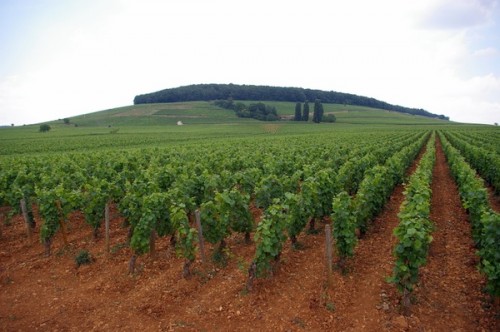
This is a written version of a talk I’m giving today at the Mornington Peninsula Pinot Noir celebration.
Pinot Noir is the grape variety that seems to inspire the most devotion in wine lovers. Finding great Pinot is a lifetime quest, filled with challenges and disappointments. But the highs make this quest worthwhile, and there is a lot of fun to be had along the journey.
Today’s topic is the alchemy of people, place and time. All are involved in forging and enjoying great Pinot Noir.
First, people. Wine is a partnership between place and people: vines are planted, wine is made, and sites are interpreted. Then, people consume the wine: when we taste, the perceptive event – our experience of the wine – is the result of the interaction between us and the wine. We bring quite a bit to the wine-tasting experience. And it is people who decide what constitutes greatness in Pinot Noir: the community of judgment. As we taste and experience and share our perceptions, we learn and decide together which wines are the best and most compelling.
Second, place. The site – terroir – is at the heart of interesting wine. Pinot Noir is a lens for interpreting site, and it’s actually a very good lens, able to distinguish among quite closely related sites, picking out characters and amplifying these differences. And it is only good sites that can produce interesting expressions of this variety. For Pinot, not all sites are created equal.
Third, we have time. There are many aspects of time that relate to Pinot. The first is vine age. Young vines produce fruity wines that display clone and climate more clearly; older vines interrogate the soil and have more resilience. They are less swayed by climate, the clonal difference isn’t as strong, and the place is more evident. There’s substance and structure. They can be picked earlier. Bottle age is another aspect of time: we expect that great Pinot should evolve in the bottle and not just survive, growing into itself. Then there’s time as in the evolution of the wine industry, as the growers learn about their site and the sorts of interpretations of it that work best and are most authentic.
I will be exploring three elements in this talk. First, how we perceive wine and how this is relevant to Pinot Noir, and discussions like this. Second, what constitutes greatness in Pinot Noir, and who gets to decide? And finally we will take a quick trawl around the world of Pinot, putting Mornington in its place.
Perception of wine is multimodal, involving all of our senses. It’s not just about taste and smell, and we don’t operate like measuring devices. This is important.
By the time we are aware of the ‘taste’ of wine, it has already gone through several processing steps that aren’t accessible to our consciousness. This is because of the way that the brain processes sensory information. It’s as if we are the CEO of a big company, and have many minions working for us. We get the executive summary, and are spared the details. This is shown beautifully in visual illusions, such as the café wall illusion, where we perceive what is not actually there. This demonstrates that some higher order visual processing has been taking place at a pre-conscious level.
We model reality, and effectively produce a map of what is out there. It’s a useful abstraction that helps us navigate the world. We don’t have all the details: a map that is an exact correspondence to the world would be useless. Look at the wonderful simplicity and utility of the London Underground map first devised by Harry Beck in 1931. It doesn’t correspond with reality, but instead is purely about utility.
The fact that our brain is creating reality for us has relevance to wine tasting. We need to be humble in the face of wine, and recognize that our experience of wine has something to do with us as well as what is in the glass. Also, the language we have for wine will in some way shape our perception of wine.
So who gets to decide what greatness is in Pinot Noir? What does great Pinot look like? Here we enter the world of aesthetics. We decide together what is great as a community of judgment. We taste together; learn together; we share our notions of good versus bad. Then we reach a degree of agreement about what is great, although we need to recognize that sometimes conflicting aesthetic systems arise, such as the US critics and the field of natural wine.
What is great Pinot Noir?
- Its first duty is to be elegant and refined
- Sweet fruit is an important element
- It should have non-fruit complexity, with structural and savoury components
- Layers of flavour are needed
- Texture matters: silky, fine-grained
- The ability to develop with some bottle age
- Global properties such as complexity and harmony matter
How can this be achieved?
- The right soils and climate: Pinot thrives at its margins and soils matter a great deal.
- Viticulture practices such as planting density, organics/biodynamics, soil health, canopy management, row orientation, picking decisions
- Winemaking practices such as sorting, use of stems, maceration, extraction, yeasts, bacteria, fermentation and cellar temperature, pressing, use of oak or alternative elevage, size and age and origin of oak, racking, pre-bottling interventions, closure type.
These all work together to produce great Pinot Noir, and there is no recipe that can be copied. It depends on where you are working
Finally, a tour of the Pinot world.
Burgundy casts a large shadow over the world of Pinot Noir. It’s the birthplace of the variety, and a place of pilgrimage for Pinot lovers across the globe. It is the defining example of terroir in action, and understanding its intricacies is a lifetime’s work.
Initial attempts to make world class Pinot Noir elsewhere, were, judged by today’s standards, a little naïve. They revolved around finding similar climates as judged by the crude metric of growing degree days. Little consideration was given to soils. But over recent decades, top quality Pinot Noir has emerged from elsewhere, speaking with a different accent but sharing the qualities of elegance, texture and ethereal perfume that Pinot lovers desire.
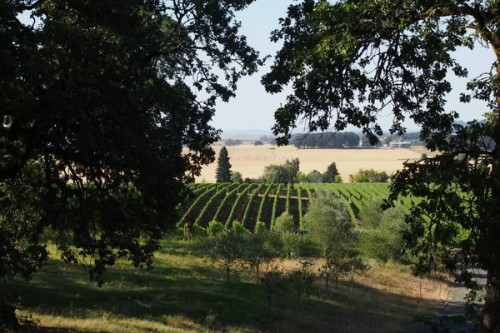
Oregon began its journey with Pinot Noir in the 1960s, and the pioneer there was David Lett of Eyrie. With their annual Pinot Noir celebration and Steamboat winemaker’s workshop, Oregon is now firmly established as a source of compelling Pinot. But it is still a work in progress, with some wines still championing power over elegance.

California is at an exciting phase for Pinot, with a move to cooler sites, earlier picking and sensitive winemaking, as demonsrated by the members of the recently disbanded In Pursuit of Balance movement. The Santa Rita Hills (Santa Barbara County) and Sonoma Coast seem to be particular hot spots. But there are still a lot of big, dark Pinots made in the state.
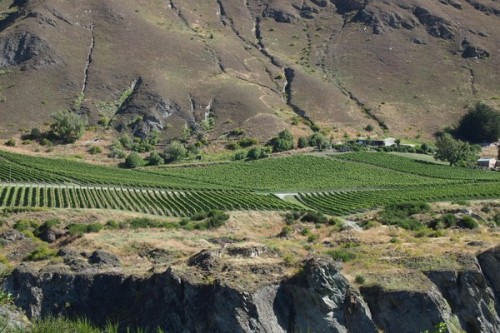
New Zealand has been on a rapid journey with its Pinot Noir. Martinborough led the way, followed closely by Central Otago in the late 1980s. There are some really interesting wines being made here, and winegrowers have been on quite a steep learning curve. Now that there’s some vine age, many of the wines are showing an extra dimension. And terroir prospectors have begun to find some very interesting terroirs.
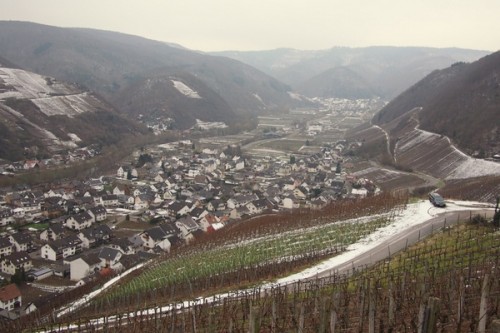
Germany makes a lot of Pinot Noir, and there are some very good ones, although the impression I have is that some of the wines are a bit over-rated, fetching high prices because of local demand. But the best are really compelling. I have a particular soft spot for wines from the Ahr Valley, which makes some really lovely wines from distinctive schist terroirs.
Elsewhere? There are some good South African Pinots from the cooler regions (Elgin, Hemel-en-Aarde), and Chile is beginning to make some progress. Alsace makes a lot of Pinot, although there’s not much that has really wowed me.
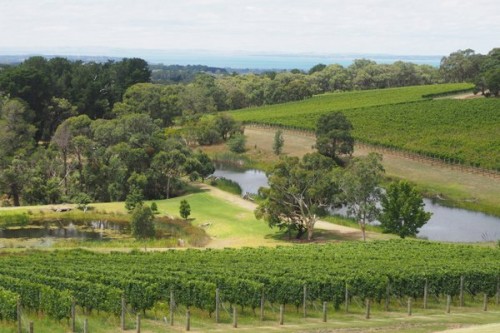
Where does the Mornington Peninsula fit in? I’ve spent three days exploring and so far have found some very impressive Pinot Noirs here. The best show elegance but also some substance and structure. There are also some interesting differences to do with soil type and elevation. Over the next couple of days we’ll no doubt explore these in more detail.
3 Comments on Pinot Noir: the alchemy of people, place and time
Bonjour Jamie
Limoux shouldn’t be overlooked. If you can find Domaine Begude, which is an organic domaine owned by Brit James Kinglake you’ll have
Burgundian quality at Languedoc prices.
Jamie,
Beautiful picture and summary of a complex and delicate variety, our favorite!
Great article!
Jamie
Just to add to your excellent review: The modern wine industry in New Zealand dates to 1975 beginning with experimental plantings if vitis vinifera by Rolfe and Lis Mills of Rippon Vineyard in Central Otago, and concurrently, Nobilo Vintners in Auckland on the North Island. Mills planted the Rippon Vineyard in 1982 and released their first commercial Pinot Noir in 1989. The first commercial release of Pinot Noir from Central Otago was from pioneer Alan Brady of Gibbston Valley Winery in 1987. The first wine grapes in Central Otago actually date to 1864 when Frenchman John Desire Feraud was attracted to the area by the Dunstan Gold Rush of 1862. Commercial winemaking thrived for 20 years thereafter, but the role of Pinot Noir at that time is uncertain.
The first vineyards were planted in Martinborough in 1978 by Alistair Taylor.
The history of winegrowing in Marlborough dates to 1873 and continued on a commercial basis beginning in 1973.
Like much of wine history, the “who planted first” validation for Pinot Noir is not known for sure. Wikipedia claims Canterbury led the way in New Zealand with successful commercial Pinot Noir in 1984 followed by Martinborough and then Central Otago. One thing is for sure, the Pinot Noir industry in New Zealand began in the late 1970s and early 1980s.